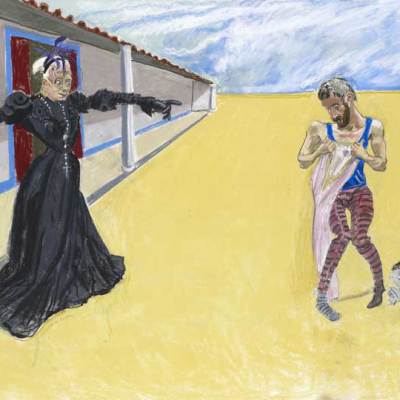From the October issue of Apollo: preview and subscribe here
Organising a travelling exhibition on an artist best known for his work in pastels is a difficult task for a curator. Pastel, or paintings in crayon, on either vellum or paper, are fragile and sensitive to damage from poor handling and vibration, as well as exposure to excessive light and changes in humidity. As a result, many public and private collections refuse to lend their treasured works and display them only occasionally in dimly lit corridors. High insurance premiums are a further deterrent to would-be borrowers. Despite the brilliance of the technique, where the pigments are often applied unmixed and unfixed to the support, many pastels have suffered from fading, abrasion, and loss of pigment. However, when protected by glass, backboards and their original gilt-wood frames, works of art in pastel can offer a rewarding aesthetic experience, especially if the works in question were created by masters from the ancien régime: Maurice-Quentin de La Tour (1704–88), Jean-Baptiste Perronneau (1715–83) and Jean-Étienne Liotard (1702–89).
Liotard Laughing (Self-portrait) (c. 1770) Jean-Etienne Liotard Photo: Nathalie Sabato © Musée d’art et d’histoire, Ville de Genève

The recent exhibition in Edinburgh on the Swiss artist Liotard, which travels to London’s Royal Academy of Arts this month (24 October–31 January 2016), is a rare treat for lovers of 18th-century art. One has to visit Dresden to see the artist’s most famous work, La Chocolatière (c. 1743–44), while the two institutions that hold the greatest collections of Liotard’s work – the Rijksmuseum in Amsterdam and the Musée d’Art et d’Histoire in the artist’s native city of Geneva – never lend the pastels they care for. These are daunting obstacles for any exhibition organiser. As such, the curators and conservators of this absorbing show, led by MaryAnne Stevens, formerly of the Royal Academy, are to be commended for assembling a judiciously selected and well-balanced group of works in all the media in which Liotard excelled: miniatures, prints, drawings, oils, and his arresting pastels, some of which have never been seen in public before. The exhibition was smaller in Edinburgh than it will be in its second showing in London; the works vary considerably, with some key institutions and collectors lending to only one venue. The beautifully produced catalogue contains some fine contextual essays, including Neil Jeffares on the medium of pastel and Aileen Ribeiro on the artist’s attentive use of dress.
The exhibition – remarkably, the first on Liotard ever to be held in Britain – succeeds in introducing his peculiar genius, his committed exoticism and his unsettling illusionism. The show is divided into five sections: ‘Self-portraits and the artist’s family’; ‘Orientalism’; British as well as Continental society portraiture; and ‘Still-life, trompe l’oeil and genre painting’. The first of these is an excellent introduction to the artist’s virtuosity. Liotard’s self-portraiture is revealed to be relentless in its self-examination and is frequently combined with an exotic role-playing. The disturbing late oil portrait, Liotard laughing (Self-portrait) (c. 1770) sees the artist grinning and pointing out of the composition at the viewer with an extended right index finger, while in other self-portraits Liotard revels in the long beard and the Turkish dress that he wore across Europe, after returning from his extended stay in Constantinople from 1738–42.
Having trained in Geneva and Paris as a miniaturist and enamellist, Liotard’s mastery of verisimilitude was used to great effect in the detailed miniatures and enamels that he occasionally produced throughout his career. A fine example in the exhibition, recently acquired by the Fitzwilliam Museum in Cambridge, is the dazzling portrait of Laura Tarsi, who is shown wearing Ottoman dress (c. 1745–49). Liotard’s portraits of his clients wearing Turkish, Levantine, and Moldavian costume became staples of his repertoire, and chimed perfectly with the fashionable international taste for turquerie. At the root of his artistic vision was a committed draughtsmanship, whether sketches, studies or finished portraits, usually executed in his favoured red and black chalks. An outstanding example, with its pure clarity of line and observation, is the costume study of a young woman in profile (c. 1737), which was probably made in Rome just before he left for Constantinople.
A master of self-promotion, Liotard charged high prices to an elite international clientele, and he met with considerable success in Vienna, Amsterdam, Paris, London, and Geneva. However, he managed to excite jealousy only among his artistic rivals in Paris and London, notably from the English portraitist Joshua Reynolds (1723–92). The exhibition brings together some representative groups of Liotard’s portraiture for key patrons. These include the meticulous finished drawings in red and black chalks made in Vienna during 1762 for the Empress Maria Theresa, depicting her many children, all alertly posed, including the future French Queen Marie-Antoinette. These drawings are contrasted with the series of pastels made in London during his first visit there in 1754, showing the children of Frederick and Augusta, Prince and Princess of Wales, most notably the open-mouthed Princess Louisa Anne. Her wide-eyed engagement with the artist and the viewer make this one of the most memorable 18th-century portraits of a child.
Where the exhibition succeeds best is in its display of pastels of British sitters, which were mostly made during Liotard’s stay in the Levant or while visiting London (1753–55). Whether scrutinising the Grand Tour polish of the Scottish aristocrat Viscount Mountstuart, or the poised and watchful Lady Anne Connolly, the viewer is made aware of Liotard’s precise social observation and his mastery of technique. Mostly, though, we are reminded of how the artist was capable of capturing the humanity of his sitters.
‘Jean-Étienne Liotard’ was at the Scottish National Gallery, Edinburgh, from 4 July–13 September 2015. An expanded version of the show is open at the Royal Academy of Arts, London, until 31 January 2016.
—
Catalogue by MaryAnne Stevens, Christopher Baker, William Hauptman et al. ISBN 9781907533990 (paperback), £35 (Royal Academy of Arts, London)






